Java中類型自動轉換機制的範例與分析
- WBOYWBOYWBOYWBOYWBOYWBOYWBOYWBOYWBOYWBOYWBOYWBOYWB轉載
- 2023-04-21 11:13:161878瀏覽
類型自動轉換機制解析
概述
自動類型轉換也叫隱式類型轉換
表達式的資料型別會自動提升
所有的byte型、short型別和char的值將會被提升到int型。
如果一個運算元是long型,計算結果就是long型;
如果一個運算元是float型,計算結果就是float型;
如果一個運算元是double型,計算結果就是double型。
資料型別只會自動提升,無法自動降低
int值可以賦值給long、float、double型變量,不能賦值給byte、short、char型變數
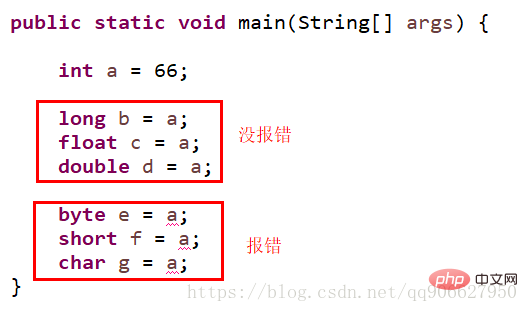
#對於函數的傳參也是一樣
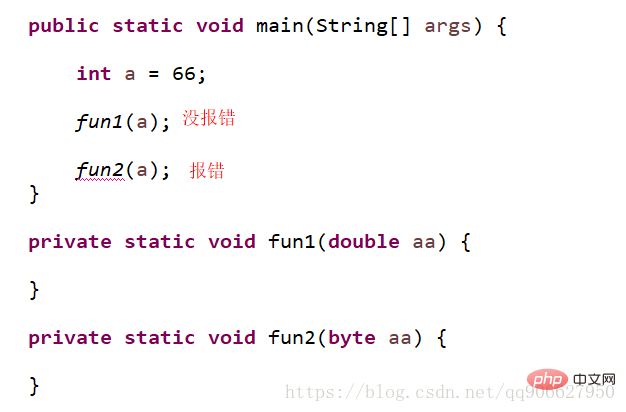
#當然,在有函數重載的情況下,java編譯器會自動選擇最匹配的函數進行呼叫
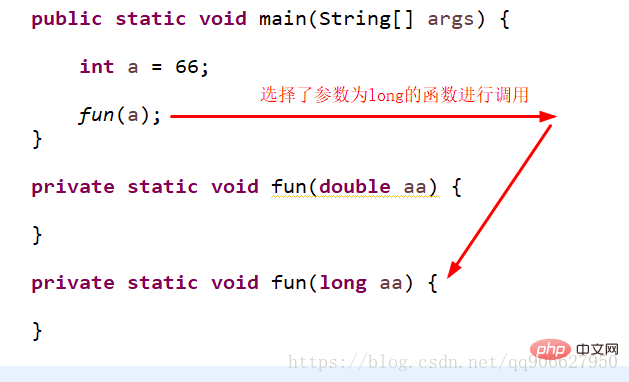
Java中整數預設的資料型別是int型別
所有長度都低於int的型別(byte、short、char)在運算之後結果將會被提升為int型
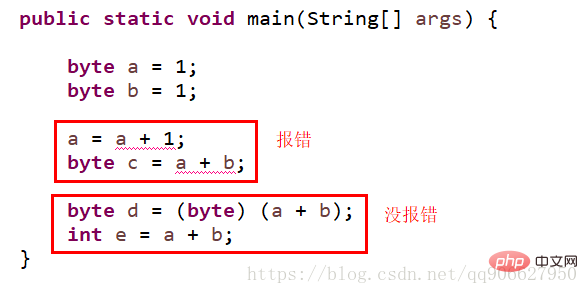
當然還有以下的這種情況,這種情況是因為我們在進行賦值運算的時候,java編譯器可以明確知道運算的結果是否超過byte或short的取值範圍,所以byte a = 1 1; 並沒有報錯。而上面 byte c = a b; 編譯出錯的原因是因為a和b都是一個變量,相加的結果是否會超過byte的取值範圍編譯器並不知道,所以編譯器將結果提升為int型了。

小結一下:
#當編譯器明確知道整數的運算結果沒有到達int的表示範圍時,byte、short或char類型的運算結果不會被自動提升為int型別
當編譯器明確知道或不清楚整數的運算結果是否到達int的表示範圍時,編譯器將會自動將運算的結果轉換成int,即使原來是byte、short或char型別。
自動型別轉換& 強制型別轉換
什麼時候會發生型別轉換
答案: 賦值| 運算時,兩邊資料型別不一致時就會發生類型轉換
如下:
public class TypeTest {
public static void main(String[] args){
// 运算时发生的隐式类型转换,两整数相除得到的还是一个整数
byte a = 3;
byte b = 4;
int num = a + b;
System.out.println(num); // 7
// 赋值时发生的隐式类型转换
int ch = '0';
System.out.println(ch); // 48
// 运算时发生的强制类型转换
byte a1 = 12;
byte a2 = 12;
byte num1 = (byte)(a1 + a2);
System.out.println(num1); // 24
// 赋值时发生的强制类型转换
short b3 = 1234;
byte a3 = (byte) b3;
System.out.println(a3); // -46
}
}運行截圖:

#類型轉換分類
自動型別轉換
強制型別轉換
#自動型別轉換(隱含型別轉換)
#規則:從小到大,低位元組自動提升到高位元組
##byte(1位元組) – > short( 2位元組)-- > int(4位元組) – > long(8位元組) --> float(4位元組) – > double(8位元組)#> float(4位元組) – > double(8位元組)
char (2位元組)-- > int(4位元組) – > long(8位元組) --> float(4位元組) – > double(8位元組)
畫圖分析:

程式碼展示:
public class TypeDemo {
public static void main(String[] agrs){
// byte -- > short
byte b1 = 127;
short s1 = b1;
System.out.println(s1); // 127
// short -- > int
short s2 = 30000;
int i = s2;
System.out.println(i); // 30000
// int -- > long
int num = 2100000000;
long lg = num;
System.out.println(num); // 2100000000
// long -- > float
long lg1 = 200000000000000L;
float f1 = lg1;
System.out.println(f1);// 2.00000001E14
// float -- > double
float f2 = 3.14f;
double d1 = f2;
System.out.println(d1); // 3.140000104904175
// char -- > int
char ch = 'a';
int i1 = ch ;
System.out.println(i1); // 97
// char -- > long
char ch2 = 'b';
long lg2 = ch2;
System.out.println(lg2); // 98
// char -- > double
char ch3 = 'c';
double dou = ch3;
System.out.println(dou); // 99.0
// char -- > float
char ch4 = 'd';
float f3 = ch4;
System.out.println(f3); // 100.0
}
}執行截圖:
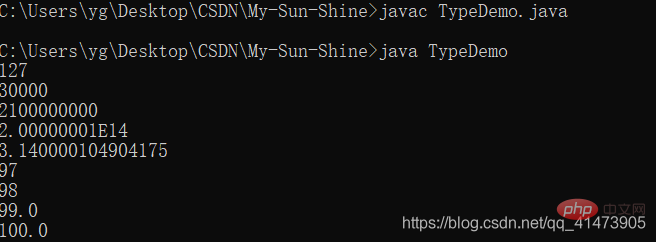
注意:
byte、short不能和char進行相互轉換
程式碼展示:
public class TypeDemo2 {
public static void main(String[] agrs){
// byte -- > char
byte bt = 127;
char ch = bt;
System.out.println(ch);
// short -- > char
short sh = 12;
char ch2 = sh;
System.out.println(ch2);
}
}編譯錯誤截圖:

float雖然是4個位元組,但是float比long表示的資料範圍更大。說明資料範圍的大小和位元組的大小不一定相關
程式碼展示:
public class TypeDemo3 {
public static void main(String[] agrs){
long lg = 20000000000000L;
float f1 = lg;
System.out.println(f1); // 1.99999997E13
}
}運行截圖:

boolean類型不能參與型別轉換
程式碼展示:
public class TypeDemo4 {
public static void main(String[] agrs) {
boolean flag = 12;
int flag1 = flag;
System.out.println(flag1);
}
}編譯錯誤截圖:
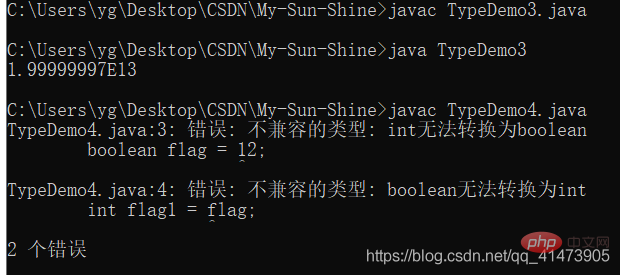
#強制型別轉換(顯式型別轉換)
規則:從大到小,高位元組手動強制轉換到低位元組
#########
double(8字节) – > float(4字节) – > long(8字节) – > int(4字节) – > short (2字节)-- > byte(1字节)
double(8字节) – > float(4字节) – > long(8字节) – > int(4字节) – > char(2字节)
画图分析:

(掌握)格式:目标数据类型 变量名 = (目标数据类型) 变量 | 常量;
代码展示:
public class TypeDemo5 {
public static void main(String[] agrs){
// float -- > long
// final float PI = 3.14f;
// long num = (long) PI; // 3
// float little = 3.14f;
// long num = (long)little; // 3
long num = (long)3.14f;
System.out.println(num);// 3
// double -- > float
// double dou = 3.14;
// float little1 = (float)dou; // 3.14
// float little1 = (float) 3.14d; // 3.14
final double dou = 3.14;
float little1 = (float)dou;
System.out.println(little1); // 3.14
// long -- > int
// long num1 = 2000000000000L;
// int num2 = (int)num1; // -1454759936
// int num2 = (int)2000000000000L; // -1454759936
final long num1 = 2000000000000L;
int num2 = (int)num1;
System.out.println(num2); // -1454759936
// int --> short
// int num3 = 12;
// short num4 = (short)num3; // 12
// short num4 = (short)40000; // -25536
final int num3 = 60;
short num4 = (short)num3;
System.out.println(num4); // 60
// short -- > byte
final short sh = 12345;
byte bt = (byte)sh;
System.out.println(bt); // 57
short sh2 = 78;
bt = (byte) sh2;
System.out.println(bt); // 78
}
}运行截图:

注意:
强制类型转换有数据丢失,一般不建议使用
代码展示:
public class TypeDemo6 {
public static void main(String[] agrs) {
short a = 1245;
byte b = (byte)a;
System.out.println(b);
}
}运行截图:

以上是Java中類型自動轉換機制的範例與分析的詳細內容。更多資訊請關注PHP中文網其他相關文章!

